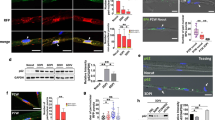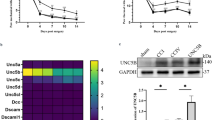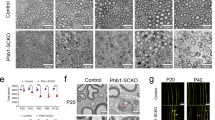Abstract
We have used an experimental model of tellurium (Te)-induced demyelinating neuropathy in the rat to study cellular mechanisms involved in the early response of myelinating Schwann cells (SCs) to injury, prior to demyelination. Starting at postnatal day 21, weaned rats were fed a diet containing 1.1% elemental Te. The animals were killed daily within the 1st week of Te diet and the sciatic nerves were processed for the ultrastructural and immunocytochemical studies. Immunohistochemistry revealed that Te induces an increased nuclear expression of c-Fos in SCs. By electron microscopy analysis, the early cytoplasmic alteration was a dramatic disorganization of the rough endoplasmic reticulum (ER) with cisternal dilations and redistribution and loss of membrane-bound ribosomes. This was followed by a prominent activation of the macroautophagy in SCs. This process involved the formation of autophagosomes containing well-preserved cell organelles, autolysosomes with cellular remnants in various phases of degeneration and lysosomes. Te treatment also induced the expression of free ubiquitin in the perikaryal region of the SC cytoplasm. Immunogold electron microscopy showed the subcellular distribution of ubiquitin in the cytosol, around of dilated ER cisterns and in the matrix of autolysosomes and residual bodies. At the nucleolar level, fibrillarin immunofluorescence revealed nucleolar segregation in SCs exposed to Te. The ultrastructural study confirmed the segregation of the nucleolar components with a peripheral distribution of the dense fibrillar component. These results support the hypothesis that the depletion of cholesterol induced by Te treatment triggers a stress response in myelinating SCs mediated by immediate early genes of the fos family. The cellular response includes a severe disruption of the protein synthesis machinery, namely the rough ER and nucleolus, with the subsequent activation of both ubiquitin and autophagic pathways of proteins and cell organelle degradation. This cytoplasmic remodeling may represent a cytoprotective mechanism in the response of SCs to a neurotoxic stress. Furthermore, it must be a prerequisite for the induction of phenotypic changes and cell repair mechanisms in SCs.
Similar content being viewed by others
Author information
Authors and Affiliations
Additional information
Received: 25 May 1998 / Revised, accepted: 8 August 1998
Rights and permissions
About this article
Cite this article
Calle, E., Berciano, M., Fernández, R. et al. Activation of the autophagy, c-FOS and ubiquitin expression, and nucleolar alterations in Schwann cells precede demyelination in tellurium-induced neuropathy. Acta Neuropathol 97, 143–155 (1999). https://doi.org/10.1007/s004010050967
Issue Date:
DOI: https://doi.org/10.1007/s004010050967




